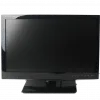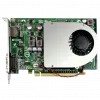Separate Video more commonly known as S-Video, and sometimes incorrectly referred to as Super Video and also known as Y/C, is an analog video signal that carries a video data as two separate signals: lumen (luminance) and chroma (color). This differs from composite video, which carries picture information as a single lower-quality signal, and component video, which carries picture information as three separate higher-quality signals. S-Video carries standard definition video (typically at 480i or 576i resolution), but does not carry audio on the same cable.
The 4-pin mini-DIN connector (shown at right) is the most common of several S-Video connector types. Other S-Video connector variants include 7-pin locking "dub" connectors used on many professional S-VHS machines, and dual "Y" and "C" BNC connectors, often used for S-Video patch bays. Early Y/C video monitors often used RCA connectors that were switchable between Y/C and composite video input. Though the connectors are different, the Y/C signals for all types are compatible.

Pin 1: GNDGround (Y)
Pin 2: GNDGround (C)
Pin 3: YIntensity (Luminance)
Pin 4: CColor (Chrominance)
The luminance (Y; gray-scale) signal and modulated chrominance (C; color) information are carried on separate synchronised signal and ground pairs.
In composite video, the luminance signal is low-pass filtered to prevent crosstalk between high-frequency luminance information and the color sub-carrier. S-Video maintains the two as separate signals, so that detrimental low-pass filtering is unnecessary. This increases bandwidth for the luminance information, and also subdues the colour crosstalk problem. The infamous dot crawl is eliminated. This means that S-Video leaves more information from the original video intact; thus, it offers an improved image reproduction compared to composite video.
Due to the separation of the video into brightness and color components, S-Video is sometimes considered a type of component video signal; however, it is also the poorest, qualitywise, being far surpassed by the more complex component video schemes, like RGB. What differentiates S-Video from these higher component-video schemes is that S-Video carries the color information as one signal. This means that the color has to be encoded in some way, and as such, NTSC, PAL, and SECAM signals are all decidedly different through S-Video. Thus, for full compatibility, the connected devices not only have to be S-Video compatible, but also compatible in terms of color encoding. In addition, S-Video suffers from reduced color resolution. NTSC S-Video color resolution is typically 120 lines horizontal (approximately 160 pixels edge-to-edge), versus 250 lines horizontal for a DVD-encoded signal, or 30 lines horizontal for standard VCRs.
When used for connecting a video source to a video display that supports both 4:3 and 16:9 display formats, the PAL television standard provides for signaling pulses that will automatically switch the display from one format to the other. The S-video connection transparently supports this operation. The S-Video connection also has general provision for widescreen signaling through a DC offset applied to the chrominance signal; however, this is a more recent development, and is not widely supported.










